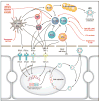Present and future therapies of hepatitis B: From discovery to cure
- PMID: 26239691
- PMCID: PMC4681668
- DOI: 10.1002/hep.28025
Present and future therapies of hepatitis B: From discovery to cure
Abstract
Hepatitis B virus (HBV) is a significant global pathogen, infecting more than 240 million people worldwide. While treatment for HBV has improved, HBV patients often require lifelong therapies and cure is still a challenging goal. Recent advances in technologies and pharmaceutical sciences have heralded a new horizon of innovative therapeutic approaches that are bringing us closer to the possibility of a functional cure of chronic HBV infection. In this article, we review the current state of science in HBV therapy and highlight new and exciting therapeutic strategies spurred by recent scientific advances. Some of these therapies have already entered into clinical phase, and we will likely see more of them moving along the development pipeline.
Conclusion: With growing interest in developing and efforts to develop more effective therapies for HBV, the challenging goal of a cure may be well within reach in the near future.
© 2015 by the American Association for the Study of Liver Diseases. This article has been contributed to by U.S. Government employees and their work is in the public domain in the U.S.A.
Figures


References
-
- Ott JJ, Stevens GA, Groeger J, Wiersma ST. Global epidemiology of hepatitis B virus infection: new estimates of age-specific HBsAg seroprevalence and endemicity. Vaccine. 2012;30:2212–2219. - PubMed
-
- Kennedy PT, Sandalova E, Jo J, Gill U, Ushiro-Lumb I, Tan AT, Naik S, et al. Preserved T-cell function in children and young adults with immune-tolerant chronic hepatitis B. Gastroenterology. 2012;143:637–645. - PubMed
-
- Vanwolleghem T, Hou J, van Oord G, Andeweg AC, Osterhaus AD, Pas SD, Janssen HL, et al. Re-evaluation of hepatitis B virus clinical phases by systems biology identifies unappreciated roles for the innate immune response and B cells. Hepatology. 2015 - PubMed
-
- McMahon BJ. The natural history of chronic hepatitis B virus infection. Hepatology. 2009;49:S45–55. - PubMed
-
- Prati D, Taioli E, Zanella A, Della Torre E, Butelli S, Del Vecchio E, Vianello L, et al. Updated definitions of healthy ranges for serum alanine aminotransferase levels. Ann Intern Med. 2002;137:1–10. - PubMed
Publication types
MeSH terms
Substances
Grants and funding
LinkOut - more resources
Full Text Sources
Other Literature Sources
Medical
